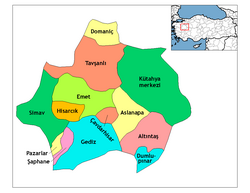Kütahya
| Kütahya | |
|---|---|
| Municipality | |

Kütahya Clock Tower
|
|
 Location of Kütahya within Turkey. |
|
| Location of Kütahya within Turkey. | |
| Coordinates: 39°25′N 29°59′E / 39.417°N 29.983°ECoordinates: 39°25′N 29°59′E / 39.417°N 29.983°E | |
| Country |
|
| Region | Aegean |
| Province | Kütahya |
| Area | |
| • District | 2,484.16 km2 (959.14 sq mi) |
| Elevation | 970 m (3,180 ft) |
| Population (2012) | |
| • Urban | 224,898 |
| • District | 248,054 |
| • District density | 100/km2 (260/sq mi) |
| Time zone | FET (UTC+3) |
| Website | www.kutahya.bel.tr |
Kütahya (Turkish pronunciation: [cyˈtahja]) is a city in western Turkey with 237,804 inhabitants (2011 estimate), lying on the Porsuk river, at 969 metres above sea level. It is the capital of Kütahya Province, inhabited by some 564 294 people (2011 estimate). The region of Kütahya has large areas of gentle slopes with agricultural land culminating in high mountain ridges to the north and west. The city's Greek name was Kotyaion, Latinized in Roman times as Cotyaeum.
Kütahya is remembered as Cotyaeum during classical times. It later became part of the Roman province of Phrygia Salutaris, but in about 820 became the capital of the new province of Phrygia Salutaris III. Its bishopric thus changed from being a suffragan of Synnada to a metropolitan see, although with only three suffragan sees according to the Notitia Episcopatuum of Byzantine Emperor Leo VI the Wise (886-912), which is dated to around 901-902. According to the 6th-century historian John Malalas, Cyrus of Panopolis, who had been prefect of the city of Constantinople, was sent there as bishop by Emperor Theodosius II (408-50), after four bishops of the city had been killed. Two other sources makes Cyrus bishop of Smyrna instead. The bishopric of Cotyaeum was headed in 431 by Domnius, who was at the Council of Ephesus, and in 451 by Marcianus, who was at the Council of Chalcedon. A source cited by Lequien says that a bishop of Cotyaeum named Eusebius was at the Second Council of Constantinople in 553. Cosmas was at the Third Council of Constantinople in 680–681. Ioannes, a deacon, represented an unnamed bishop of Cotyaeum at the Trullan Council in 692. Bishop Constantinus was at the Second Council of Nicaea in 692, and Bishop Anthimus at the Photian Council of Constantinople (879), No longer a residential bishopric, Cotyaeum is today listed by the Catholic Church as a titular see.
...
Wikipedia

